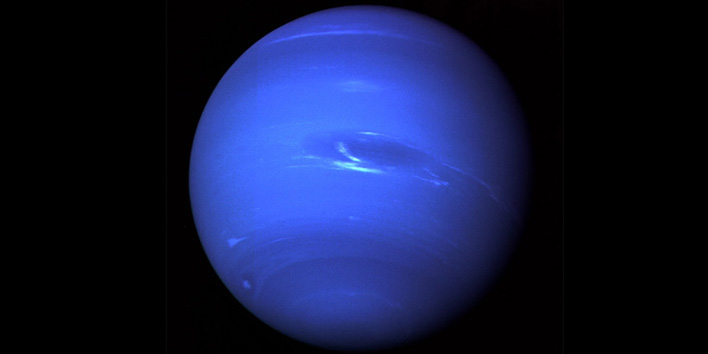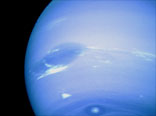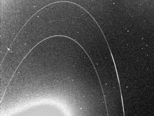Neptune is the eighth planet from the sun. Now that Pluto is no longer regarded as a true planet, Neptune is the farthest planet from the sun. Only one spacecraft has ever visited this planet in a flyby because it would be impossible to land on its non-solid surface. It captured photos and information. These photos and other observations made through telescopes show that it is a dark, cold planet with supersonic winds.

What Makes Neptune Interesting?
The brilliant blue appearance makes Neptune a delight to the eye. This is in contrast to the turbulent and extremely cold atmosphere made up of gases and characterized by the worst hurricanes in the solar system. There are plenty other interesting facts about this planet that make it one of the most interesting bodies in the solar system.
How Did Neptune Come To Be?
Scientists believe that Neptune formed from a buildup of a solid core followed by the capture of hydrogen and helium gases in the nebula near the early sun. The solid core formed the rocky inner core while the gases formed the atmosphere. It is thought that the formation process lasted 1-10 million years. [http://adsabs.harvard.edu/abs/2000ApJ…544..481B]
Who Discovered Neptune?

Neptune is the first planet located through mathematical predictions before it was observed through a telescope. It was discovered in 1846 by astronomer Johann Galle. Before that, Galileo had seen it through his telescope in 1612 and 1613 and concluded it was a fixed star. It is named after the Roman god of the sea and water.
What Was The First Mission to Neptune?
The first and only spacecraft to have visited Neptune is the Voyager 2 in 1989. However, the spacecraft could not land because of the planet’s non-solid surface and high gravity. It merely flew by capturing photos and information that led to discovery of more information about this planet. No person has ever been on a mission here. There are no missions planned in the near future.
How Far Away Is Neptune?
Neptune is the most distant planet from the sun. It is 30 times farther from the sun than the earth is. In fact, only 1/900 of the sun’s energy that reaches the earth ever reaches Neptune. When Voyager 2 was sent on a mission to explore it, it took 12 years for it to reach the planet. It takes 165 earth years for Neptune to complete a single orbit around the sun. Since its discovery in 1846, it completed its first orbit in 2011. It is impossible to observe it with the naked eyes without a powerful telescope.
What Is Neptune Made of?
Neptune is a gaseous planet without a solid surface. Its atmosphere consists of a mixture of helium, hydrogen and methane gases. There is a huge white cloud that goes around the planet in a scooting manner. The atmosphere is very deep and joins with water and other melted over a rocky inner core.
Why Does Neptune Have Such A Bright Blue Appearance?
The planet has a brilliant blue appearance and thin white sheets of clouds around the surface. The blue color is believed to be because of the methane gas in its atmosphere. However, this does not explain why the blue is so intense. The cause of this brightness must be a component of its atmosphere that is yet to be discovered.
Neptune Moons

So far, 13 moons have been discovered. Six moons were photographed by Voyager 2 and five more irregular moons were seen through a telescope. The largest moon is Triton, which orbits the planet in a direction opposite to the one followed by the other moons. This indicates that Neptune may have captured Triton unlike the other moons that formed on its atmosphere. Triton is one of the coldest bodies ever discovered in the solar system. However, observations indicate that its atmosphere is active and growing warmer due to unknown reasons.
Neptune is The Smallest of the Gas Giants
Neptune is one of the four gas giants and also the smallest and outermost. The other gas giants include Jupiter, Saturn and Uranus. While smaller in size, it is more massive than Uranus making it denser than Uranus. Its diameter is about 30, 200 miles, which is close to 4 times larger than that of the earth.
Neptune Has the Strongest Winds in the Solar System

Neptune winds blow at supersonic speeds. This is amazing given that its atmosphere is extremely cold. Neptune winds blow at a speed of 1,500 miles per hour. This is like three times the speed of the worst hurricanes on earth.
Neptune’s Rings

Neptune has six thin dark rings circling it almost like those of Saturn. However, Neptune’s rings have inconsistent thickness and sometimes look like arcs. These rings are believed to be relatively new and expected to last for only a while.
Neptune’s “Great Dark Spot” That Disappeared

Pictures of Neptune taken by Voyager 2 showed a giant storm known as the “Great Dark Spot.’’ However, recent photos of the planet taken by Hubble Space Telescope showed no signs of the spot. Instead, there were two other dark spots that eventually disappeared. It is believed that the first spot was a big storm that ended and the other two were smaller storms that also disappeared with time.
What Makes Going To Neptune Difficult?
Even with the advances in space travel, no person has ever visited this planet. First of all, Neptune is extremely far away. It would take very many years to arrive. Even after arriving, it would be impossible to land on the surface because of the gaseous atmosphere. The only way a person could visit is in a secure spacecraft in a flyby.
Photo Sources: NASA http://solarsystem.nasa.gov/planets/profile.cfm?Object=Neptune&Display=Gallery&Page=1
